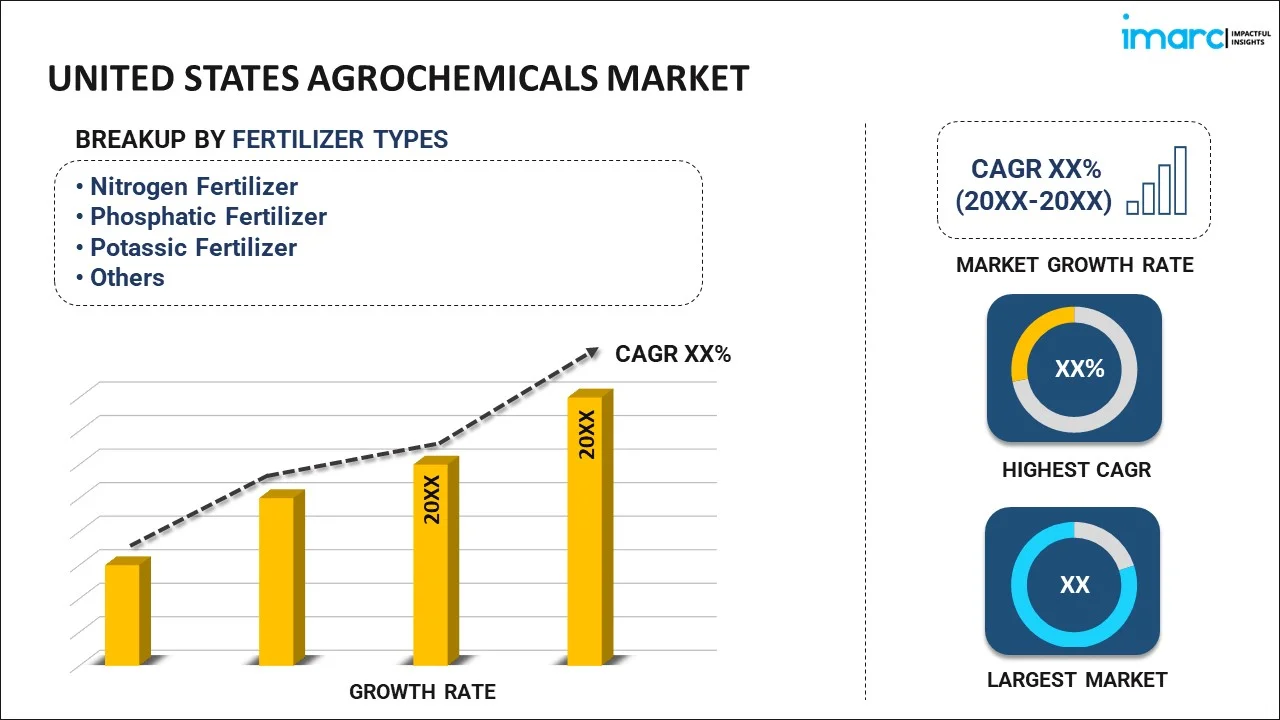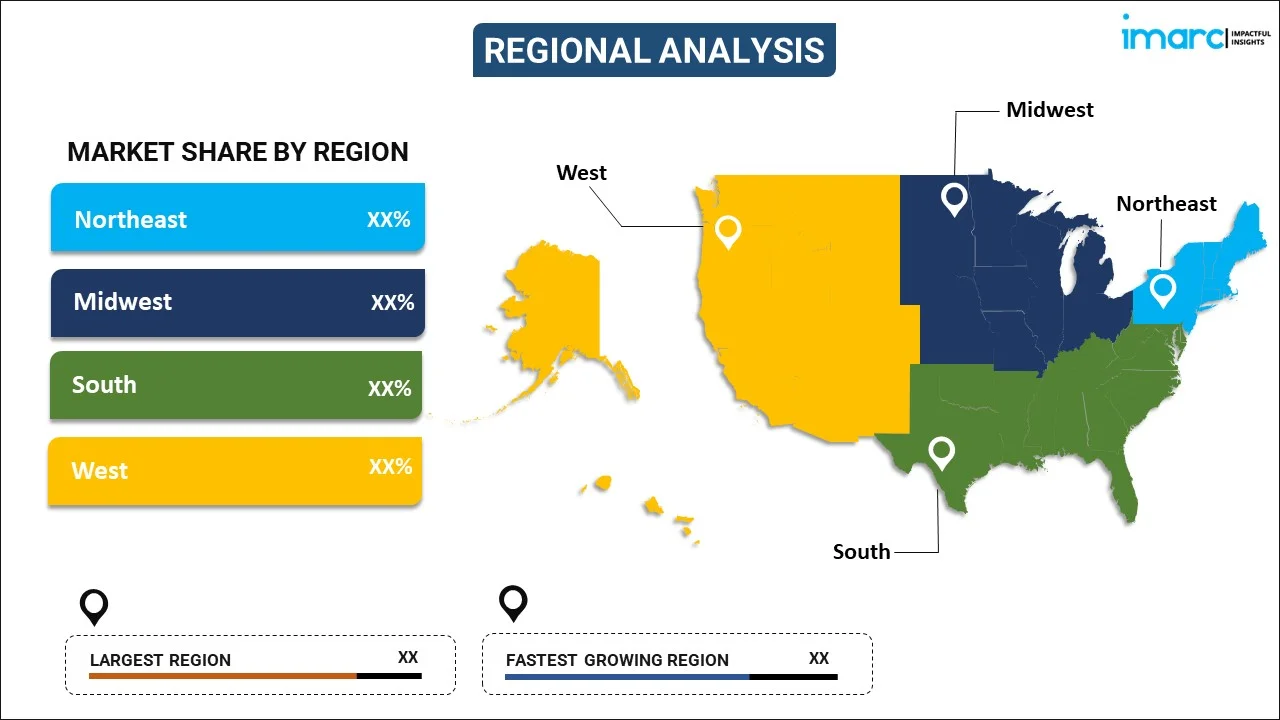
United States Agrochemicals Market Report by Fertilizer Type (Nitrogen Fertilizer, Phosphatic Fertilizer, Potassic Fertilizer, and Others), Pesticide Type (Fungicides, Herbicides, Insecticides, and Others), Crop Type (Cereals and Grains, Oilseeds and Pulses, Fruits and Vegetables, and Others), and Region 2025-2033
Market Overview:
The United States agrochemicals market size reached USD 34.5 Billion in 2024. Looking forward, IMARC Group expects the market to reach USD 52.2 Billion by 2033, exhibiting a growth rate (CAGR) of 4.3% during 2025-2033. The growing population and food demand, increasing awareness about environmental sustainability climate variability, ongoing research and development, favorable government support to adopt innovative agrochemical practices and advancements in agrochemical technology represent some of the key factors driving the market.
|
Report Attribute
|
Key Statistics
|
|---|---|
|
Base Year
|
2024 |
|
Forecast Years
|
2025-2033
|
|
Historical Years
|
2019-2024
|
| Market Size in 2024 | USD 34.5 Billion |
| Market Forecast in 2033 | USD 52.2 Billion |
| Market Growth Rate (2025-2033) | 4.3% |
Agrochemicals refer to a broad category of chemical substances used to enhance crop production and protect plants from pests, diseases, and weeds. These chemicals play a vital role in modern agriculture by improving crop yields and ensuring food security for a growing global population. Agrochemicals encompass several key categories, including fertilizers, pesticides, and herbicides. Fertilizers provide essential nutrients like nitrogen, phosphorus, and potassium to plants, promoting healthy growth and increased crop yields. Pesticides are designed to control and manage pests that can damage crops, reducing the risk of yield loss and ensuring food quality. Herbicides target unwanted weeds that compete with crops for resources, helping to maintain the overall health of the cultivated plants.
United States Agrochemicals Market Trends:
The continuous increase in the US population, coupled with rising global food demand, drives the need for higher agricultural productivity. Agrochemicals, such as fertilizers and pesticides, are essential for maximizing crop yields to meet this demand. Additionally, climate change and unpredictable weather patterns pose challenges to agriculture. Agrochemicals, particularly those that enhance drought resistance or protect against new pests and diseases, are crucial for adapting to changing environmental conditions. Other than this, the increasing awareness about environmental sustainability and consumer demand for organic and sustainably produced food has led to a shift toward more environment-friendly agrochemicals. Besides this, economic factors, including crop prices, farm income, and input costs, play a significant role in agrochemical usage. Farmers make decisions about agrochemical applications based on their economic viability. In line with this, the United States agrochemicals market is influenced by global trade dynamics, including imports and exports of agricultural products and agrochemical inputs. Trade policies and agreements can affect market access and competitiveness. Furthermore, consumer preferences for sustainably produced and pesticide-free foods can influence the choices made by farmers and, in turn, the agrochemicals market. Apart from this, government subsidies, incentives, and agricultural policies can impact agrochemical usage. Support for research, development, and adoption of innovative agrochemical practices can stimulate market growth. Moreover, ongoing research and development efforts in the agrochemicals industry led to the creation of new and improved products. Moreover, advancements in agrochemical technology have led to the development of more efficient and targeted products. Precision agriculture techniques, including the use of drones and GPS technology, enable farmers to apply agrochemicals more precisely, reducing waste and environmental impact.
United States Agrochemicals Market Segmentation:
IMARC Group provides an analysis of the key trends in each segment of the market, along with forecasts at the country level for 2025-2033. Our report has categorized the market based on fertilizer type, pesticide type, and crop type.
Fertilizer Type Insights:

- Nitrogen Fertilizer
- Phosphatic Fertilizer
- Potassic Fertilizer
- Others
The report has provided a detailed breakup and analysis of the market based on the fertilizer type. This includes nitrogen fertilizer, phosphatic fertilizer, potassic fertilizer, and others.
Pesticide Type Insights:
- Fungicides
- Herbicides
- Insecticides
- Others
A detailed breakup and analysis of the market based on the pesticide type have also been provided in the report. This includes fungicides, herbicides, insecticides, and others.
Crop Type Insights:
- Cereals and Grains
- Oilseeds and Pulses
- Fruits and Vegetables
- Others
The report has provided a detailed breakup and analysis of the market based on the crop type. This includes cereals and grains, oilseeds and pulses, fruits and vegetables, and others.
Regional Insights:

- Northeast
- Midwest
- South
- West
The report has also provided a comprehensive analysis of all the major regional markets, which include Northeast, Midwest, South, and West.
Competitive Landscape:
The market research report has also provided a comprehensive analysis of the competitive landscape. Competitive analysis such as market structure, key player positioning, top winning strategies, competitive dashboard, and company evaluation quadrant has been covered in the report. Also, detailed profiles of all major companies have been provided.
United States Agrochemicals Market Report Coverage:
| Report Features | Details |
|---|---|
| Base Year of the Analysis | 2024 |
| Historical Period | 2019-2024 |
| Forecast Period | 2025-2033 |
| Units | Billion USD |
| Scope of the Report | Exploration of Historical and Forecast Trends, Industry Catalysts and Challenges, Segment-Wise Historical and Predictive Market Assessment:
|
| Fertilizer Types Covered | Nitrogen Fertilizer, Phosphatic Fertilizer, Potassic Fertilizer, Others |
| Pesticide Types Covered | Fungicides, Herbicides, Insecticides, Others |
| Crop Types Covered | Cereals and Grains, Oilseeds and Pulses, Fruits and Vegetables, Others |
| Regions Covered | Northeast, Midwest, South, West |
| Customization Scope | 10% Free Customization |
| Post-Sale Analyst Support | 10-12 Weeks |
| Delivery Format | PDF and Excel through Email (We can also provide the editable version of the report in PPT/Word format on special request) |
Key Questions Answered in This Report:
- How has the United States agrochemicals market performed so far and how will it perform in the coming years?
- What has been the impact of COVID-19 on the United States agrochemicals market?
- What is the breakup of the United States agrochemicals market on the basis of fertilizer type?
- What is the breakup of the United States agrochemicals market on the basis of pesticide type?
- What is the breakup of the United States agrochemicals market on the basis of crop type?
- What are the various stages in the value chain of the United States agrochemicals market?
- What are the key driving factors and challenges in the United States agrochemicals?
- What is the structure of the United States agrochemicals market and who are the key players?
- What is the degree of competition in the United States agrochemicals market?
Key Benefits for Stakeholders:
- IMARC’s industry report offers a comprehensive quantitative analysis of various market segments, historical and current market trends, market forecasts, and dynamics of the United States agrochemicals market from 2019-2033.
- The research report provides the latest information on the market drivers, challenges, and opportunities in the United States agrochemicals market.
- Porter's five forces analysis assist stakeholders in assessing the impact of new entrants, competitive rivalry, supplier power, buyer power, and the threat of substitution. It helps stakeholders to analyze the level of competition within the United States agrochemicals industry and its attractiveness.
- Competitive landscape allows stakeholders to understand their competitive environment and provides an insight into the current positions of key players in the market.
Need more help?
- Speak to our experienced analysts for insights on the current market scenarios.
- Include additional segments and countries to customize the report as per your requirement.
- Gain an unparalleled competitive advantage in your domain by understanding how to utilize the report and positively impacting your operations and revenue.
- For further assistance, please connect with our analysts.
 Inquire Before Buying
Inquire Before Buying
 Speak to an Analyst
Speak to an Analyst
 Request Brochure
Request Brochure
 Request Customization
Request Customization




.webp)




.webp)












